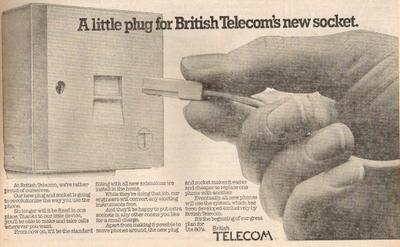
 A Rhapsody table telephone in tan leather from BT, released in 1981. Why? I dunno.
A Rhapsody table telephone in tan leather from BT, released in 1981. Why? I dunno.
In 1981, BT began to sell telephones for the first time.
So, perhaps the 1981 leather job happened in a fit of excitement as the BT designers sought to capture the imaginations (and cash) of those looking to buy a phone?
Maybe.
Ken Masters (Stephen Yardley), the medallion man of Howards' Way, had one of these phones (or something very similar) beside his bed in early episodes of the series, which began in 1985. And that absolute charmer Polly Urquhart (Patricia Shakesby) was also seen brandishing something very like it for several seasons.
Classy.
With phones on sale for the very first time in the early 1980s, that terrific 1960s innovation, the trimphone suddenly went colourful!
Read all about it here.
 The new BT phone sockets arrived on the 19th of November 1981, and this advertisement from The Sun dates from 23/11:
The new BT phone sockets arrived on the 19th of November 1981, and this advertisement from The Sun dates from 23/11:
At British Telecom, we're rather proud of ourselves.
Our new plug and socket is going to revolutionise the way you use the phone.
No longer will it be fixed in one place. Thanks to our little device, you'll be able to make and take calls wherever you want.
From now on, it'll be the standard fitting with all new extensions we install in the home.
Whilst they're doing that job, our engineers will convert any existing instruments free.
And they'll be happy to put extra sockets in any other rooms you like for a small charge.
Apart from making it possible to move phones around, the new plug and socket makes it easier and cheaper to replace one phone with another.
Eventually all new phones will use the system, which has been developed exclusively by British Telecom.
It's the beginning of our great plan for the 80s.
Londoners were introduced to another BT innovation in 1981, as the Times, 28/7, reported...
Plastic Money for Phones
Public telephones which use pre-paid plastic cards, are now in operation in London. (Bill Johnstone writes). They will soon appear in Birmingham, Glasgow and Manchester.
The telephones, called Cardphones, take cards of the same shape and size as a credit card. Each represents so many 5p call units. Two types are available: 40 units (value £2) or 200 units (£10).
Callers insert the card instead of coins and a digital readout on the telephone gives the value still left on the card as the call progresses.
The cards are available in London from Post Offices and some John Menzies and Travellers Fare kiosks at railway stations.
They can be used for inland and international calls. About 200 Cardphones will be in use for the trial and if they are successful more will be introduced. Radio Times, November 1985.
Radio Times, November 1985.
 In 1980, Post Office Telecommunications became British Telecom and would become a totally separate public corporation on 1 October 1981.
In 1980, Post Office Telecommunications became British Telecom and would become a totally separate public corporation on 1 October 1981. October 1981 - Buzby tops "hate" poll!
October 1981 - Buzby tops "hate" poll!



























